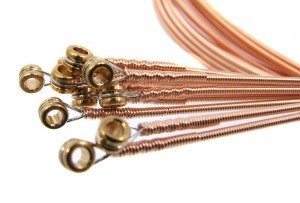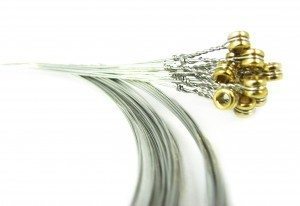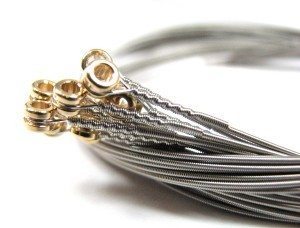 Of all of the three-string cigar box guitar tunings, the most popular is probably the G D G open G tuning. Featured on many how-to-play videos on YouTube and CigarBoxNation.com, this tuning has become the de facto standard for 3-string slide blues.
Of all of the three-string cigar box guitar tunings, the most popular is probably the G D G open G tuning. Featured on many how-to-play videos on YouTube and CigarBoxNation.com, this tuning has become the de facto standard for 3-string slide blues.
A lot of new builders run into the question of how they achieve this tuning – which strings they should use, whether to go with larger strings or smaller, and so I wanted to try to demystify the topic.
First, a disclaimer: these recommendations are made based on our experimentation in the C. B. Gitty shops, and it is what we have found to work. Other people may have different opinions, and they are welcome to them. I’m not trying to set any standards or lay down any laws – I am just going to tell you what works for us.
These Open G string sets and Many More available over at www.CBGitty.com!
The Four Possible GDG Tunings
Basically, on a 3-string cigar box guitar with a scale length in the range of 24 to 25 1/2 inches (scale length being the distance between the nut and the bridge), there are 4 different configurations of GDG that you can have, ranging from the bassiest to the most trebly. Theoretically there are more potential combinations, but we’re just focusing on the cases where you have 3 strings of different sizes, strung from low to high pitch:
- Low – Middle – Middle (Low G, Middle D, Middle G)
- Low-Middle-High (Low G, Middle D, High G)
- Low-High-High (Low G, High D, High G)
- Middle-High-High (Middle G, High D, High G)
 Each one of these will have a different overall sound and feel. The first one will use all wound strings, and will have the strongest bass of the four. The fourth one uses only one wound string, and will be the most high-pitched and trebly.
Each one of these will have a different overall sound and feel. The first one will use all wound strings, and will have the strongest bass of the four. The fourth one uses only one wound string, and will be the most high-pitched and trebly.
Deciding which option is right for you is mostly a matter of preference, and experimentation. All four can be used to play tablature and lessons intended for guitars tuned to GDG. You have to decide whether you want the low growly bass of the low strings, the treble of the high strings, or a mix).
Just Looking for Gitty’s Recommendation? Here You Go
If I had to arbitrarily make a recommendation of which one you should use, I would probably go with #3: Low G, High D, High G. This is the tuning we use on our Pure & Simple Cigar Box Guitar Kits, and it is a nice mix – you get that low thumpy bass G note on the bottom end, but then the nice strong treble of the High D and High G. The result sounds great!
The second recommendation would probably be #2 – the two lower wound strings and the high G on the upper end. The bass influence will be heavier in this but you still keep that nice clear high G on the top end for playing the melody of a song and doing leads. This is what we tend to use on the Pure & Simple Cigar Box Guitars we build in-house.
Now, on to Strings
Basically, there are 5 potential strings that are needed to achieve these 4 tunings. They are:
- Low G
- Middle D
- Middle G
- High D
- High G
If you think of a standard 6-string guitar, or if you want to use a standard guitar string pack to do these tunings, you can think of it like this:
- Low G – take the low A string (second biggest wound string) and tune it down a full step to G.
- Middle D – this is the same as the D string on a standard guitar – third biggest wound string.
- Middle G – this is the same as the middle G string on a standard guitar – the smallest of the wound strings
- High D – the easiest way to get this is to tune the High E string (the smallest, unwound string) down a full step to D. You could also crank the unwound B string up two full steps (which would put it in the break zone).
- High G – For this one you’d need to take a lighter-gauge high E string and crank it up two full steps to G.
String Weights and Gauges
If you want to know recommended string gauges for buying in bulk, then the chart below should help you pick out the specific gauges you’ll need. Remember that moving to a larger string gauge means you’ll have to crank it tighter to reach the same pitch, compared to a smaller gauge.
Also remember that the chart below is specifically for “standard” scale instruments, that fall an inch or so on either side of a 25″ scale length.
We give both “heavy”, “medium” and “light” recommendations below, so you can pick a set best suited to your instrument. Heavier strings will have to be cranked tighter than light string sets to reach the right pitch, and this will put more tension on your guitar, bowing your neck more, etc. I recommend starting with the lighter gauge strings and experimenting from there.
These sizes should work with both acoustic and electric guitar strings. Generally electric guitars are strung on the lighter gauge size. The gauges below are hyperlinked to the bulk strings listings at CBGitty.com, where available.
| Desired Note/Pitch | Light Gauge | Medium Gauge | Heavy Gauge |
| Low G | .042″ Wound | .044″ Wound | .046″+ Wound |
| Middle D | .030″ Wound | .034″ Wound | .036″+ Wound |
| Middle G | .022″ Wound | .026″ Wound | .028″+ Wound |
| High D | .012″ Plain Steel | .013″Plain Steel | .014″+ Plain Steel |
| High G* | .009″ Plain Steel | .009 Plain Steel | .010″+ Plain Steel |
* Because this is such a high note to try to reach on a 25″ scale, there is not as wiggle room in terms of string size. Trying to crank anything much bigger than .009″ or .010″ up to high G is a recipe for broken strings. .008″ strings are available, but I’ve never used them.
Finally! Specific String Size Sets for Specific Tunings
These exact Open G string sets and Many More available over at www.CBGitty.com!
So from all of this, we can get some recommended string sizes to achieve the 4 tunings mentioned above. For this example I’ll list the “Light Gauge” sizes, but you should be able to easily pick out the medium or heavy gauge sizes if you want.
- Low G – Middle D – Middle G: .042″ Wound, .030″ Wound, .022″ Wound
- Low G – Middle D – High G: .042″ Wound, .030″ Wound, .009″ Plain Steel
- Low G – High D – High G: .042″ Wound, .012″ Plain Steel, .009″ Plain Steel
- Middle G – High D – High G: .022″ Wound, .012″ Plain steel, .009″ Plain Steel
The Wiggle Room Factor: you can generally get by with a little larger or little smaller string for any given pitch. Each string has its ideal tension zone, but the edges of that zone are a bit gray. If you keep breaking a string trying to hit  a particular pitch, try a smaller gauge string! If a string seems too loose and flappy, move to a larger gauge string.
a particular pitch, try a smaller gauge string! If a string seems too loose and flappy, move to a larger gauge string.
So there you have it! Hopefully this will make this sometimes arcane-seeming subject a little easier to understand for folks. I will be working on more articles like this to cover some other popular tunings as well, such as Open D (D A D), Open E (E B E), etc.
Thanks for reading, I hope you found it useful!


Hi looking for advice,
I want to be able to tune up (or down) to be able to use one guitar for Open D and E. without too much tension on the neck. (Hardwoods with laminated frets)
Right now I have strings for both keys,
D .052
A .022
D .012
So…install the DAD and tune up?
Thanks
You’ve got a great question, TW.
I’ll use this example to answer.
Low – Middle – Middle for a 25-inch scale length cigar box guitar is Low G (G2), Mid D (D3), and Mid G (G4).
For further investigation, you may find this resource valuable: https://wahiduddin.net/calc/calc_guitar_tension_from_size.htm
And if you have any further questions, please do not hesitate to reach us at [email protected].
We’re happy to help!
Hi,
Apologies if this is a silly question Or if it’s covered elsewhere, but I just ordered a CBG and haven’t really played a guitar before…and I last played a trumpet back in the 70’s… so I’m trying to wrap my brain around tuning and octaves…
I’ve cut and pasted the suggested variations of GDG tuning from one of your other postings and I’ve added in what I think are the correct octave notations—are these right (assuming that Middle C is C4)?
Low – Middle – Middle
(Low G (G3), Mid D (D4), Mid G (G4))
Low-Middle-High
(Low G (G3), Mid D (D4), High G (G5))
Low-High-High
(Low G (G3), High D (D5), High G (G5))
Middle-High-High
(Mid G (G4), High D (D5), High G (G5))
Thanks for any help for this true beginner,
TW
Hey Rich, Sorry for the delay in response.
Yes! As long as the string gauge matches up it will work just fine.
Great site, I’m building a resonator and want to achieve #2, it’s 25.5″ scale, the strings I was thinking about using are almost spot on per your recommendations, .042, .032, .009, except they are not the same strings, meaning they are in a pack of Ernie Ball Coated Slinky, the set has .042,.032,.024, unwound .016,.011,.009. So in essence, the right string size, but instead of using the ADe strings I’ll be using the EAe strings of the set, will this be a problem?
Thanks
Rich
Good Morning Adrian,
Yes, that is the tuning that you would shot for for a lighter gauge. Low, Middle and High here refer to the pitch of the note when the string is tuned to proper note.
The list below might also help lay it out, as it gives a basic hz range between each note and where they sit by string gauge.
https://www.cigarboxguitar.com/knowledge-base/master-string-size-tuning-list-for-25-inch-scale/
Love the site but can’t get my head around low, middle and high when no tuner I’ve come across uses that system.
If I use the light gauge strings recommended above and want to go low, high, high; do I tune G2, D4, G4?
Hey there Jerry!
Gitty made a Dulci-lele with some nylon strings that sounded pretty great, so they should work for you.
We generally use clip-on tuners, which give us an accurate reading of the note. However, the following was passed along to me by another member of the community and it might help.
Low G 98 HZ. Middle D 146 HZ. and Middle G 196 HZ
Csn i use nylon strings on cigar box 3 string guitar? For the open gdg tuning, what are the frequencies for tuning?
Yes using banjo strings is fine. Using smaller gauge strings will give you a higher, more trebly sound on a cigar box guitar, and using larger wound strings will give you a lower, more bluesy sound. It is entirely up to you to decide which you prefer.
I have used banjo strings on my home made 3 string cigar box guitar using d b and g strings. Should I be using something different? Is using banjo strings ok? Does this give it a different sound. I have no frets marked and just built one using a web site on u tube. A fretless guitar…interested in simply playing slide guitar. I know very little about music.
GDG or DAD are great tunings, you may just want to bump each string up one size from what you’d use on a 25-inch scale.
What’s a good tuning for a 23″ scale, 3 string cbg?
There are no rules, in regards to sound hole size or really anything else with cigar box guitars. If you want a larger sound hole, make a larger sound hole. In our opinion .75″ to 1″ is really all that is needed to let the maximum volume out, but people (including us) do other sizes for various reasons. Don’t get too hung up about details like this.
You recommend sound holes totalling 3/4 to 1 inch total. But the illustration in your instructions seems a darn bit bigger than that. and I notice seemingly larger holes on many CBG videos. Am I missing something?
Lane… this article that you commented on contains our exact recommendations to do what you want to do.
What would you recommend for an acoustic setup? The extra-light acoustic string sets I have use a 0.013 for the High E string…not sure that would pull up to a G (at least, not for long.) I could go with option #1 above (Low G, Middle D, Middle G). Or just use electric strings, I guess.
Personally, I hate wound strings because of the “buzz” the generate when you just perfectly apply pressure (i guess vertically) to the wound strings when trying to finger chords, etc. Because of that, I prefer to use strings 1, 2 and 3 from a set of 6 *ELECTRIC Guitar* strings (usually purchased as individual strings) because with electric guitars, that 3rd string is not wound, so I can have all solid wire strings and my playing sounds better (though perhaps still a bit “sloppy”). But, doing this does limit me to the 4th GDG Tuning described in this article (Middle-High-High (Middle G, High D, High G)).
Just my 2 cents…
Just found your site and as I’m just starting out in CGB’s I have found it really useful.
I’m in the United Kingdom and would like to say well done on a great website !
Thanks a bunch ! Keep up the great work please. Cheers ! Eddie.
Thanks for adding the sound clips here! They are extremely helpful!! Keep the articles coming, please!
Thank you!! I have zero music or playing knowledge very helpful
And thank you for sharing your experience as well Glenn! Going with those lighter strings on a 25-inch scale, it must be nice and loose and gritty. There is definitely a place for that! My goal in writing this article was to present a “middle of the road” approach to this tuning, with string gauges that would work from roughly 24″ to 26″ scales. I need to try your 32/24/16 though!
Very interesting article. A lot of “food for thought” and it’s going to set me to doing a little experimenting. Tapping your experience, I’m going to try some of the cases you’ve described in the article to see how they sound and ‘feel’.
I’ve been building electric guitars for years and got ‘into’ building and playing CBG’s since last March. Twelve CBG’s and mudboxes so far and more in process. It’s been a blast. For which string sizes to use, I went with what I’d been using (and like) on my six string electrics – the typical set of “Extra Light” strings (.009, .011, .016, .024, .032, .042), selecting the A string (.032) tuned down one step to G, the D string (.024) and the G string (.016) for the ‘common’ G-D-g tuning on a 25.5″ scale. I’ve already cleared the local music store out of most of their loose 16’s, 24’s and 32’s. So, when I saw the title of your article I thought “Let’s see if they’re doing what I do”, but …. whoa, no 16-24-32 case. Next thought is “Am I missing something, doing something wrong?” They sound good. I’ve even sold a few. But …. time to try something different.
Thanks for sharing your knowledge and experience.
Really helpful information. Thanks!!
I’m a piano technician with a lot of piano restrings experience. Your article are for cigar box guitar same as “scale design” for piano. Great!!!
Thanks so much.
The info you are giving out is a big help to new builders and even to us old timers. Please keep it up.
You’re welcome Marty, thanks for the feedback! There’s a lot more to come, I have a long list of articles to write to keep growing the knowledgebase.
Excelant article! Trying to find this information would take forever searching the web, you have it all in one place. Thanks for the great resource in not only these articles but CBGitty as a whole!
Figuring out strings and tunings is a topic that tends to give people a lot of trouble, Tom, so you’re not alone! I am hoping that with this article, and more like it, we can help reduce some of the frustration!
Thanks Ben, I have been curious of stringsizes and tuning ,as I am new atlearning to play. Have been building less than a year and am hooked.
Tom
You can bet we will be doing more Terry, thanks for the encouragement!
Very valuable information!!
This has always been a important theme!
Many Thanks for sharing this with us!!✌️✌️✌️
These articles are all very helpful. Thanks! And keep them coming, please!